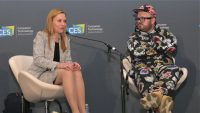CES Panel: Where the Augmented Reality Experience Is Going
January 8, 2019
Augmented reality in 2018 was “interesting, with projections being exceeded,” said NorthSouth Studios’ Bill Newell, who moderated a panel on the topic. He asked what AR experience stood out this year. IBM’s Elizabeth Kiehner, who reported on the new partnership between IBM’s Watson and Unity, was enthused over Legos’ AR app. “But I am more interested in AR as it pertains to enterprise,” she said, enumerating breakthroughs in AR for factory workers and healthcare, including surgery and cancer treatment.
Amazon Web Services’ Mark Francis noted the landmark introduction of ARCore and ARKit, as well as the shipping of Magic Leap’s glasses. RYOT (Verizon Media Group) head of content Nigel Tierney (below right, with Elizabeth Kiehner) pointed to Quick Look in iPhone, which makes native AR available on the device. “At Verizon, we’ve had success with native apps,” he said. “We just did an activation with Huffington Post. There are limitations with technology currently, but I’m excited about the democratization of AR.”

AR is still maturing, said MediaMonks’ Olivier Koelemij. “It’s almost here,” he said. “What’s working well is social shareable content for brands. But select your platform wisely — we’re still looking for effectiveness.” The fact that we’re still excited about IKEA’s 2016 AR application, he noted, “shows we’re not going very fast.”
Plantronics’ Catelyn Orsini is looking at B2B applications, particularly with augmented audio. “There aren’t a whole lot of people raising their hands in that space,” she said. “But real-time transcription in the workplace is powerful.” She noted that Bose’s headset for augmented reality is also of interest.
At law firm Holmes Weinberg, partner Michael Leventhal who specializes in AR/VR, is also focused on spatialized audio and integrating it with 3D video. “Getting those tools together is underway,” he said. “If you don’t have audio, you don’t have an immersive experience.” He noted that ODG and Meta, both pioneers in this space, are failing. “There’s a shakeout in the market,” he said. “Not all companies will survive.”
Although the vast majority of games have been built in game engines like Unity and Unreal, Francis said that the enterprise sector needs to be able to create an immersive application “without writing a line of code or being an artist.” “We want to take out the complexity and then be able to publish it widely,” he said. Kiehner pointed out Adobe’s private beta for Arrow, a low-code AR production environment that’s supposed to be as easy to use as Photoshop.
“The ability for anyone to get his or her hands dirty will help propel the adoption of technology,” she said.
In 2019, said Tierney, “5G is a real thing.” “You’ll be able to have more immersive experiences,” he said “Being able to stream photoreal images on a phone is pretty exciting.” Francis noted that, in 2019, companies will deliver experiences instead of demos. “Finding the right set of technologies and delivery platforms is the challenge today,” he said, predicting that, “by 2023, we’ll have reached saturation with native apps and we’ll be moving to robust browsers.”
Finally Leventhal noted the move to map and create a virtual world that remains constant. “The amount of data, storage and bandwidth required to populate the virtual world through the AR cloud will be massive,” he said. “A lot of people will be working on this.”

No Comments Yet
You can be the first to comment!
Sorry, comments for this entry are closed at this time.